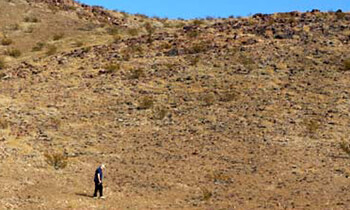Mule Canyon Ruin
Historic Point of Interest
20 miles southwest of Blanding, Utah on Highway 95
This is an easy stop on the way to Natural Bridges National Monument.
Butler Wash Ruins Overlook is 6 miles east.

No Admission Fee | Restrooms Available | Open Year Round
Location
Mule Canyon is accessed from highway 95. Look for the graded county road (SJ 263) on the north side of the highway, approximately 19 miles west of the intersection of routes 95 and 191. Go up the county road about 1/4 mile and park.Walk up the canyon to your left. Because of the orientation of this canyon, one finds slickrock walls mixed with ponderosa pines.
Description
Mule Canyon Ruin is an open Anasazi habitation site consisting of both above-ground and below-ground dwellings. This site was initially occupied briefly about 750 AD and reached its peak between 1,000 and 1,150 AD. Pottery and architecture from this location indicate a strong influence from the Mesa Verde Anasazi of southwestern Colorado, in addition to a less significant influence of the Kayenta Anasazi of northwest Arizona. Butler Wash Ruin, 6 miles east, has a square kiva, indicative of Kayenta culture.
The Anasazi were dry farmers. Botanical and archaeological studies indicate that corn, beans and squash provided the staple foods of these peoples and were supplemented by a variety of wild plants and animals.
The ruins here were excavated by a University of Utah archaeological team in 1973. The National Park Service stabilized and reconstructed the ruins the following year. The U.S. Department of Transportation constructed the parking loop and the Bureau of Land Management (BLM) constructed the kiva's protective roof, trails and restrooms. San Juan County helped fund the interpretive display. It is administered by the BLM.
Rooms
The block of 12 rooms was used by 2 or 3 families for sleeping and storage. Individuals entered these rooms through both doorways and roof hatches accessed with ladders. In good weather, cooking and other daily activities occurred on the roof or in the plazas.
Kiva
The underground kiva was the ceremonial center of the Anasazi community, just as it is today among the modern Hopi. Originally, the kiva had a roof of juniper beams covered with earth. Access to the kiva was by ladder through a hole in the roof and by a tunnel as well. It is believed that kiva ceremonials were primarily a male activity.
Tower
The circular tower was probably two stories high when in use. Authorities are unsure of the function these towers served, but celestial observation, defense, storage and communications are among the theories. Because the tower is linked to the kiva by a tunnel, some believe it served a ceremonial function. There is increasing evidence that such towers found in most Anasazi sites within the Four Corners region were all within line of sight of each other and could have been used for signaling. Mule Canyon Ruin is in direct line of sight with Cave Tower, one mile to the southwest.
Mule Canyon is managed by the Bureau of Land Management. For more information, contact:
BLM San Juan Field Office
435 North Main
PO Box 7
Monticello, Utah 84535
435-587-2144
Share this page on Facebook:
The Desert Environment
The North American Deserts
Desert Geological Terms







